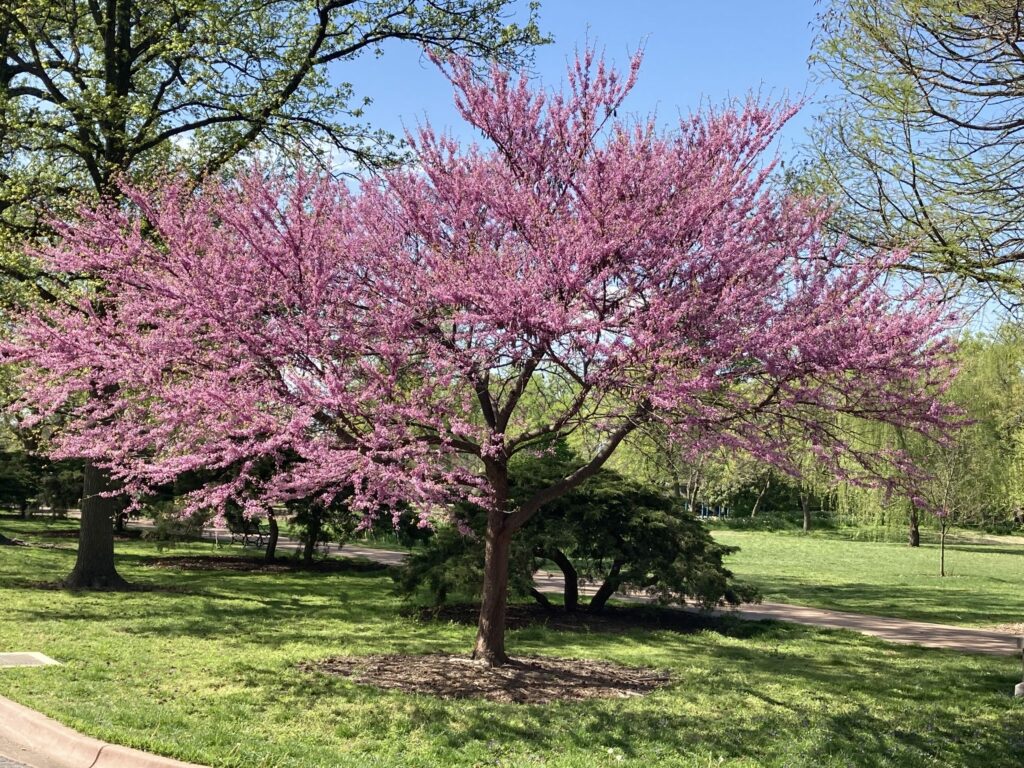Flowering dogwood might be our state tree, but Eastern redbud (Cercis canadensis) is our most reliably beautiful flowering tree. It’s ubiquitous both as a cultivated plant and as a volunteer (or ‘weed’ if you want to be rude about it), as is particularly obvious right now in April when its deep pink flowers borne on naked branches (and trunks!) streak across the landscape. If you keep your eyes open you’ll realize there are redbuds seemingly everywhere. Culturally they aren’t fussy – if the soil drains alright, they’ll take it. After the stinky, depressing spectacle of the Callery pear bloom, it’s pleasant reassurance that we have beautiful, aggressive native flowering trees as well!
This means that while planting a redbud will never score you many points for originality, you also won’t have to worry too much about the tree’s fate. I will stand by this assertion: other than trees that did not make it through the establishment phase (the risky first 3-5 years after a tree is planted), I can count on one hand the number of redbuds I have seen die. I like to say “redbuds don’t die, they just overstay their welcome.” They reach their mature size of 20-30 feet (height and spread) and while major branches and even central leaders start to die, new shoots keep emerging. These trees typically become so gruesome in appearance that they’re unsuitable for anything resembling a formal landscape, and so they are eventually removed. And if the stump isn’t ground out, it puts out shoots, and the redbud just keeps on ticking.
Redbuds are pretty fast growers, especially in their youth, meaning that you won’t have to wait long for a replacement. If you have a group of them, plant a couple small trees along with the more mature ones so they’ll be ready to fill in when the big ones start to fall apart. Or if you have the eye for it, the half-dead, half-rotten log sticking out of the ground covered with flowers that is a “mature redbud” in spring can be a lovely addition to your yard. What better reminder of the resilience of nature? What better symbol of the hope that springs promises, of new life and beauty arising from death and decay, than such a tree? When a representative of your local code enforcement department shows up, feel free to try that argument out on them.
There are so many varieties of redbud (many purple leaf varieties like ‘Forest Pansy’ are now available) that I won’t even begin to discuss them all, but two demand attention. Cercis canadensis ‘alba’ is a white-flowered variety, called unsurprisingly ‘whitebud’. Beautiful in its own right and a fantastic alternative to white-flowering non-natives, it also provides a striking counterpoint to the regular variety in a group planting. Culturally it is the same as the regular redbud – both appreciate a little shade but again, they’re not picky. Var. texensis, called Oklahoma redbud (perhaps to spite Texans?) has a much thicker, glossier leaf. It’s southern origins make it a good alternative if you’re planting in full sun, in chronically dry soil or have a hard time remembering to water your trees. There’s a redbud for absolutely any landscape niche you can imagine (even the dwarf ‘Little Woody’) – it’s a trusty native that provides excellent wildlife value and aesthetic beauty. One of our finest trees.




